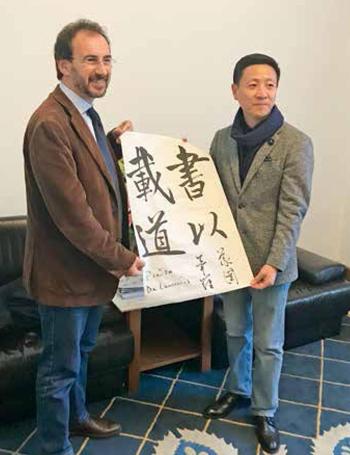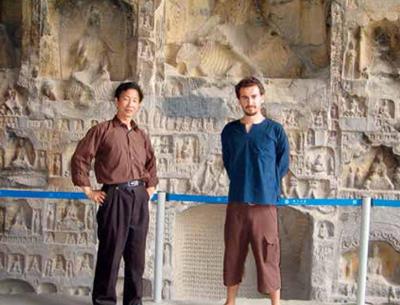我眼里的中國書法
畢羅



我再度啟程赴中國前,母親問我這次去做什么,我告訴她:意大利有達芬奇,比他再早1000多年,中國也有一位“達·芬奇”,叫王羲之,他的書法讓人嘆為觀止,值得全世界給予關注并投入研究。我這次就是去交流自己的研究成果。
自1998年第一次從意大利到中國起,我已經記不清來過多少次了。除了北京、上海這樣的大城市,我鐘愛的還有天津、西安、洛陽這些具有歷史底蘊和文化內涵的城市。當然,還有我的書法研究啟蒙地——杭州。
研究中國的“達·芬奇”
2019年春天,當我再度啟程赴中國前,母親問我這次去做什么,我告訴她:意大利有達·芬奇,比他再早1000多年,中國也有一位“達·芬奇”,叫王羲之,他的書法讓人嘆為觀止,值得全世界給予關注并投入研究。我這次就是去交流自己的研究成果。
那次學術會議——紹興論壇“源流·時代——以王羲之為中心的歷代法書與當前書法創作”,云集了國內外學者。這是我第一次在蘭亭參加曲水流觴,受邀當選“二王學研究中心”的特聘專家。
2019年年底我再一次來到紹興,是紹興圖書館邀請我作公眾演講。
很多人對我的研究感到好奇,主要是因為沒有很多西方人專門做書法研究。
紹興論壇結束以后,四川人民出版社邀請我撰寫一部跟王羲之書法有關的著作,名為《尊右軍以翼圣教》,預計于今年面世。
起初在杭州留學時,我并沒有想到今后自己將出版意大利語、英語、中文版本的與中國詩詞、書法研究相關著作。對我來說,這些只是我漢學研究向縱深推進過程中的階段性成果。漢學文化博大精深,值得探究的內容實在太多了。
我從小就有一種觀念:文化不等于書上所記載的知識。上學時,我不喜歡光看書不出門的同學——所謂的“書呆子”。雖然自己成績還比較好,我也盡量避開為讀書而讀書的人。因此,我上大學攻讀中文專業的時候,發現一大片“文化綠洲”向我敞開懷抱。當然,書上介紹的中國文化確實很有魅力,但對我來說,興趣最大的不是抽象的博大精深,而是土生土長的中國人本身。漢字和書法是我和中國人打交道的媒介。
在杭州“靠近”書法
我第一次留學中國是1998年,在北京。有同學看不慣我用毛筆寫字,他們大概認為,我的水平不夠,這好像在“冒犯”一種悠久的文化傳統。但是我想得正好和他們相反:“這是一項你喜歡的東西,干嘛不去靠近它?”我回顧這20年和中國文化包括書法的結緣,基本上可以用“靠近情緣”這個詞來概括。而我真正“靠近”它,應該說不是在北京留學那次,而是將近3年的兩次在杭州的留學。
第一次是2000~2001年,我留學中國美術學院;而后是2004~2005年我留學浙江大學。我對中國的基本看法,包括我對書法的認識和研究,基本上都成型于這兩個時間段。
1999年年底,我還在意大利讀大學時,已經和我的書法老師相識了。他的名字叫王承雄,上海人,直到現在,他還在指導我學習毛筆字。我和他一見如故,性格上很合得來,向他學習書法后也取得一些進步。但我和他都很清楚,想要了解書法是怎么回事,除了看書和請教老師以外,還必須進入原生態的書法文化環境。當時在意大利,除了王老師,我還有幾個中國朋友,都是上海人,他們也是藝術愛好者。當我與他們聊起自己打算去中國全面學習書法時,他們都建議我去杭州,一方面因為杭州有著濃厚的書法文化底蘊,另一方面杭州有中國美院。
當時的中國交通和現在相比,簡直是天壤之別。雖然大城市的地鐵系統已經相當完備,但是鐵路并沒有像現在的高鐵這么方便。我記得那時候上海南站還沒修好,只能從梅隴站坐車到杭州城站。
作為中國美院留學生,我們居住在中山中路。2000年下半年的杭州和今天的杭州不太一樣,那時的中山中路還不是現在這般繁華的旅游街區,基本上都是普通老百姓的居住地。當時杭州的交通也不像現在這么擁擠,汽車也不是非常多,自行車當然不少。我自己也買了一輛,但是我更喜歡走路,確切地說,叫“亂走”。基本上是開始走一條路,然后走向引起我注意的角落、建筑物或門面。就這樣要么繼續走,要么拐彎鉆進小路,要么停下買點小吃,基本上不會走回頭路。別說導航,我連手機都沒有,查地圖也覺得有點煩,不如就這樣散步。當然,這樣隨心隨意地走,迷路的可能性不小,但是我覺得無所謂,我在中國一直覺得到處都很安全。萬一實在找不到路了,打個車就可以回宿舍。
我們書法留學生班,一半是歐洲人,一半是日本人。雖然我們歐洲人坐在教室的左側,日本人坐在教室右側,但是我們之間的交往并沒有隔開,反而相處得非常好。當然,歐洲人和日本人在學習書法方面不可能在同一個水平上,因為我們很難把握漢字形體。作為中文系的學生,我倒還好,但其他歐洲同學都是學其他專業的,對他們來說,寫字就是“描”——看著字帖寫,如果自己發揮一下靈感揮毫,就成了畫抽象畫。
這種不太扎實的中國文化修養帶來的問題是,在美院進修書法基本上等于是學寫字。可是,我申請中國政府獎學金留學杭州的目標是要寫我的畢業論文——即后來2002年年底在意大利答辯的《正書之源流》。所以除了寫字以外,我還對學術性的書法研究有興趣,但是美院在這方面的指導不是很多。這部分文史知識是我在意大利考上博士研究生以后第二次留學杭州時才補上的。
從做研究到做交流
2003年年底考上博士以后,我立刻決定離開意大利去中國留學,因為我讀博士不是為了獲得文憑,而是為了好好做書法研究。起初報的課題是中國早期的書法文獻,但意大利包括所有的西方大學,別說書法文獻,連做書法史研究的基本條件都不具備,這意味著如果要好好做這方面的研究必須到中國去求學。另外,我和別的研究書法的漢學家有很大的不同,我非常在乎書法的實踐,并認為寫書法是研究書法的基礎和出發點,而且也只有到中國學毛筆字才有希望獲得真正的進步。我以前這么認為,到現在還是這樣認為。
有意思的是,我博士論文的選題后來改成孫過庭的《書譜》了。2001年春天我還在中國美院留學時,有一天在解放路公交車站的玻璃窗里看到正在展示的《書譜》長卷照片。我之前只知道《書譜》一頁一頁的字帖,看到長卷,覺得很震撼,更沒料到,后來孫過庭成了伴隨我好幾年的宗師和研究對象。
2004年年初,我又到了杭州,這次是到浙江大學()留學。我第一次留學杭州,在浙江大學認識了一位中國老師,名字叫易容。我于1999年在意大利接待過復旦大學教授吳中杰先生,她是吳老師的博士生。2003年,她幫我聯系了陳振濂教授,并且推薦我做他的碩士生。我當時報的其實是中文系漢語言文字專業,所以在學校學習,一半的時間在藝術系還有一半在中文系。
在浙大讀書時,我真正進入了學術研究的關鍵時期,從幼稚被動到逐漸擁有歷史透視和文化視角,這除了跟浙大優越的學習條件相關之外,還跟我當時交往的朋友有關,尤其是與我同坐一間教室的姚宇亮——如今他是廣州美術學院的教授。姚兄和其他朋友讓我注意到書法作品和書法文化中好多細微的地方,如果沒有他們的示范或提醒,光靠我自己的悟性是很難注意到的。
另外,因為學習陳老師的碩士課程的需要,學校要求我寫論文。我那時候寫過一篇意大利文的碩士畢業論文,于是又寫了一篇短短的《〈筆陣圖〉點畫形態考》。
我用一年多時間鉆研《書譜》并寫成文章《〈書譜〉文體考》,后來它成了我的博士論文、英文專著的核心內容。我記得很清楚,2005年春天陳老師看了這篇小文之后,在課堂上公開稱贊說如果再潤色一下就可以發表,我當時覺得非常得意,也算是人生的一次發現自我吧。
浙大的碩士沒讀完,我權衡再三,離開杭州回到母校繼續撰寫博士論文。這其實也是我發展的需要。作為西方青年漢學家,要有治學的學術規范,要有國際學術的視角,才能和別的學者進行對話和交流,永久留在中國也未必是最好的選擇。回到意大利后我完成了博士畢業論文,在意大利東方大學任教,并保持與中國學者的交流與聯系。
后來,我還先后到過杭州很多次,一方面是見朋友,一方面是參加學術活動。無論時間過得多快,周圍變化多大,心里存放著的美好回憶想刪也刪不掉。
2018年,我把自己近20年的中國書法學習上的經歷撰寫成十幾篇文章,陸續刊登在《書法》雜志上,算是對自己多年來游歷中國的記錄。中國人說“讀萬卷書,行萬里路”,我也愿意把行走的經歷分享給更多朋友。
2007年至2019年下半年,我在中國財經大學、廣州中山大學、陜西師范大學、上海圖書館、紹興圖書館等多所大學或圖書館,作了面向專業學生及公眾的演講。將近15年的時間里,我在中國舉辦各種講座,每場講座都與聽眾有特別開心、活躍的互動,這是我最珍惜的一種體驗。這也確實證明,書法不僅僅是高校的藝術,也是屬于全民的一種文化精髓。
Chinese Calligraphy as I See It
By Pietro De Laurentis (Italy)
I first visited China in 1998. Since then I have visited the oriental country numerous times. Of the cities in China, I love Beijing and Shanghai for various reasons and I love Tianjin, Xian and Luoyang for their rich historical heritage and cultural wealth. Hangzhou is unique, however, because it gave me enlightenment on Chinese calligraphy.
In the spring of 2019, I visited Shaoxing and attended a ceremony in honor of Wang Xizhi (303-361), a great Chinese master of calligraphy, whom I referred to as Chinas Da Vinci when I explained the purpose of my visit to my mother. “His amazing calligraphy demands the attention of the world. I will submit my research result and engage in exchanges with international colleagues,” I explained.
International and Chinese scholars attended the event. I was engaged as a specialist at a research center there. At the end of 2019 I gave a lecture at Shaoxing Municipal Library. Many people there were curious about my research, mainly because they knew there were few westerners specialized in Chinese calligraphy. After the public lecture in Shaoxing, Sichuan Peoples Press engaged me to write a book about Wang Xizhis calligraphy. The book is scheduled to be published in 2020.
When I began studying Chinese calligraphy in Hangzhou in 2000, I had the slightest idea that I was to write books in Italian, English and Chinese about Chinese poetry and calligraphy. The first calligraphy course I took at China Academy of Art in Hangzhou lasted from 2000 to 2001. The second calligraphy course I took at Zhejiang University in Hangzhou lasted from 2004 to 2005. My understanding of China and calligraphy took shape during these two special courses.
I took interest in Chinese calligraphy in 1999 in an Italian university. I had a Chinese calligraphy teacher named Wang Chengxiong, a native of Shanghai. I have been practicing Chinese calligraphy under Wangs guidance since then. I met Wang and we became friends pretty fast. With him as my teacher I made fast progress in writing Chinese. I had a few Chinese friends who also hailed from Shanghai. When I chatted with them about my intention to study calligraphy in China, they unanimously suggested Hangzhou: Hangzhou is a city of calligraphy and the city hosts China Academy of Art. I knew clearly that I needed to be in an authentic atmosphere to experience Chinese calligraphy.
So I came to Hangzhou in 2000. As an international student of China Academy of Art, I lived in a special dorm near the campus. Back then, Hangzhou was relatively underdeveloped. I bought a bicycle and pedaled around randomly in my spare time. Whenever I started a bike adventure, I picked a road arbitrarily. As I pedaled along, I enjoyed going wherever distractions and attractions led me. I never followed the same road back. I just moved ahead. I felt safe in China and even if I got lost, I could easily find a taxi to get back to the dorm.
The course at the academy was a primary one. What I learned there was the essentials of how to use a brush pen to write. However, this course did not give me enough to write a dissertation on the sources of Chinese calligraphy. I had applied for a Chinese scholarship for writing the dissertation to be submitted and then defended toward the end of 2002 in Italy. I was interested in academic study of Chinese calligraphy, but the course I took at the academy was in another direction.
After I became a doctoral candidate toward the end of 2003, I immediately made up my mind to take a course in Hangzhou, for I really wanted to know everything about Chinese calligraphy. I needed to take a close look at the calligraphy literature in early history of China. Such a study was not likely in Italy. And unlike some sinologists who studied Chinese calligraphy, I wanted to be an excellent calligrapher. Writing like a qualified calligrapher would help a great deal for a profound academic study of calligraphy. Only in China can an international student become a really good calligrapher. I still think so today.
Interestingly enough, it was during my second study in Hangzhou that I dismissed the previous doctoral dissertation and decided to focus on? by Sun Guoting (646-691), a Chinese calligrapher of the early Tang Dynasty. The work was the first important theoretical work on Chinese calligraphy, and has remained important ever since, though only part of it survived. I happened to see a copy of the treatise in a display gallery by a bus stop in Hangzhou in the early 2001 when I was taking my first course in calligraphy at China Academy of Art. I was profoundly impressed by the grandeur and elegance of the long scroll replica which is 9.06 meters long.
The second course I took was a graduate course at Zhejiang University. I studied under the guidance of Professor Chen Zhenlian, a prominent calligrapher. It was at Zhejiang University that I got really immersed in academic studies. I learned to view academic issues from historical and cultural perspectives. I made rapid progress largely because of the rich resources available at the university and because I got useful help and feedback from classmates in the same course. Among them was Yao Yuliang, now a professor of Guangzhou Academy of Fine Arts. Yao and other friends directed me to take a closer look at the nuances of calligraphy, which I wouldnt have noticed if they hadnt guided or demonstrated to me. As I planned to write a treatise for the graduate course, I spent more than a year writing a treatise titled? in Chinese. In the spring of 2005, Professor Chen examined my treatise and praised me in front of all my classmates. He said the treatise was good enough for publishing with some minor amendments. I was very happy. This treatise later became the core of my doctoral dissertation. After the doctoral dissertation, I wrote a book which was centered on the graduate treatise.
I did not finish my graduate course at Zhejiang University. After weighing pros and cons of several options, I decided to give up the graduate course and go back to Italy to finish my doctoral study. As a sinologist in the west, I need to abide by an international academic perspective before I can conduct a dialogue with other sinologists. I finished my doctoral dissertation and attained a PhD degree. Now I teach at University of Naples “LOrientale”. I have kept constant contact with Chinese colleagues and friends.
Since then I have visited Hangzhou many times for taking part in academic programs and meeting friends.
In 2018, I wrote a dozen articles about my 20-year experiences in China. They were published in , a professional monthly founded in 1977 and based in Shanghai.
From 2007 to the second half of 2019, I held public lectures at universities and libraries across China. The interaction between the public and me at these lectures was pleasurable and eye-opening. I cherish such an experience because I think the positive response of the public means that calligraphy is more than an academic subject studied only at higher education institutions and that it is a cultural experience the public appreciate and enjoy.

